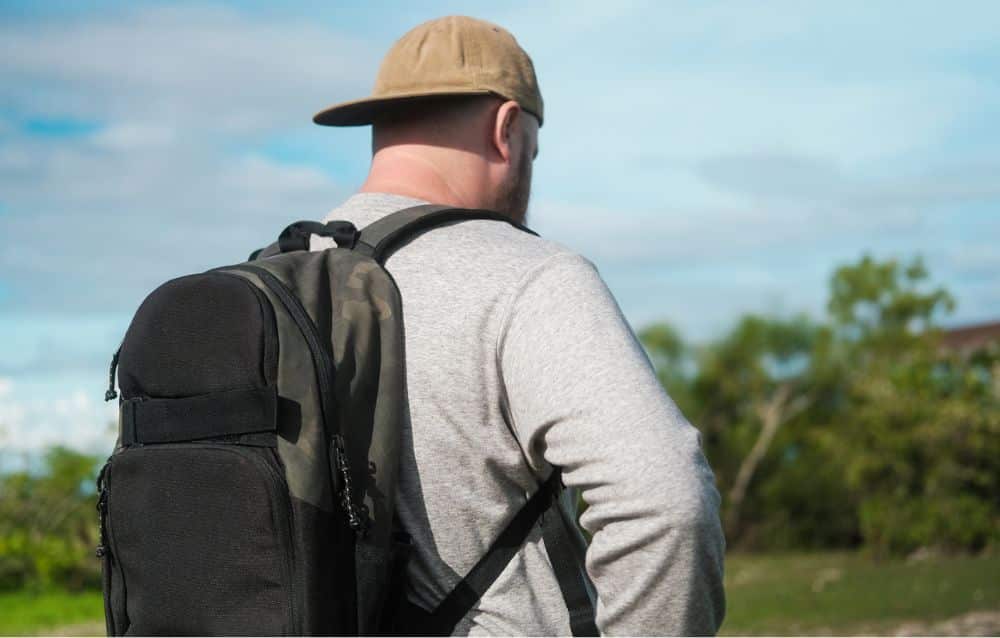Looking for a low-impact workout that builds strength and endurance at the same time? Rucking just might be the PERFECT option for you. It’s this old-school, time-tested military training method.
And lately it’s gained popularity among fitness enthusiasts. You’ll be a fan, too. With rucking, you get awesome results with hardly any equipment needed. Of course, like any activity you gotta make sure you’re doing it safely and effectively.

Rucking Basics
Rucking is just walking with weight on your back via a backpack. The term originates from “rucksack,” the military name for a backpack. While soldiers have been rucking for centuries as part of their training, us regular folk have taken on this activity for its numerous health benefits and accessibility.
Research published in the Journal of Strength and Conditioning Research shows that carrying additional weight while walking increases caloric expenditure by approximately 30-40% compared to regular walking. And that makes it an awesome-sauce calorie-burning exercise.
Science-Backed Benefits of Rucking
Rucking brings a lot to the table in terms of why you should do it. Here’s some of the benefits of adding rucking to your fitness routine:
- Cardiovascular and Strength Training Combined: Unlike traditional cardio that neglects strength building, rucking simultaneously elevates your heart rate while strengthening your core, legs, and posture muscles.
- Joint-Friendly Exercise: Studies from the American College of Sports Medicine indicate that rucking creates less impact on joints than running while still providing cardiovascular benefits.
- Improved Posture and Core Strength: The additional weight encourages proper posture engagement, as demonstrated in a 2018 study that found load carriage strengthens postural stabilizers.
- Significant Calorie Burn: A 180-pound person rucking with a 20-pound pack at a moderate pace burns approximately 500-600 calories per hour, compared to around 350 calories walking without weight.
- Accessible Outdoors Activity: Requires minimal equipment and can be performed virtually anywhere.
Essential Gear for Beginners
The Rucksack
Your choice of pack is an important one when it comes to comfort and injury prevention:
- For Beginners: Start with whatever durable backpack you already own that features padded shoulder straps and ideally a chest strap for stability.
- Specialized Rucking Packs: As you progress, consider investing in purpose-built rucking backpacks from brands like GORUCK, 5.11 Tactical, or Mystery Ranch, which offer ergonomic designs specifically for weighted walking.
- Key Features: Look for packs with adequate padding, adjustable straps, and a frame sheet to distribute weight evenly across your back.
Keep in mind that just starting is really important. Even something like an adidas backpack is enough for you to get started with this activity.
The Weight
For safety and progression, you gotta select an appropriate weight for the pack:
- Starting Weight: Begin with 10% of your body weight. For a 180-pound person, that’s roughly 18 pounds.
- Weight Options:
- Purpose-made ruck plates (flat steel or sandbags designed to fit in backpacks)
- Household items wrapped in towels (books, water bottles)
- Sandbags (inexpensive but effective)
- Weight Distribution: Position the weight high between your shoulder blades and close to your back for optimal biomechanics.
Footwear
Proper shoes help prevent injuries during weighted walks:
- Support: Choose shoes with good arch support and cushioning
- Durability: Trail runners or lightweight hiking shoes work well
- Fit: Ensure adequate toe box room, as feet may swell during longer rucks
How to Start Rucking Safely
Proper Technique
Maintaining correct form prevents injury and maximizes benefits:
- Posture: Stand tall with shoulders back and down, chest up
- Core Engagement: Keep your core muscles gently activated
- Stride: Take natural steps, neither overstriding nor shuffling
- Pack Position: The pack should rest high on your back, not sagging low
Beginner’s Progression Plan
A systematic approach prevents overtraining:
Week 1-2:
- Distance: 1-2 miles
- Weight: 10% of body weight
- Frequency: 2-3 times per week
- Pace: Comfortable walking speed
Week 3-4:
- Distance: Increase to 2-3 miles
- Weight: Maintain same weight
- Frequency: 3 times per week
- Pace: Slightly increase pace as comfort allows
Week 5-8:
- Distance: Build to 3-4 miles
- Weight: Consider adding 5 more pounds if initial weight feels manageable
- Frequency: 3-4 times per week
- Pace: Moderate walking pace
Historical research on military training protocols suggests that gradual progression is key to adaptation. In a study of military recruits, those who increased load gradually experienced 30% fewer injuries than those who rapidly increased weight.
Common Mistakes to Avoid
Learning from others’ experiences can accelerate your progress:
- Starting Too Heavy: Beginning with excessive weight risks injury and discouragement
- Neglecting Hydration: Weighted exercise increases fluid needs
- Poor Pack Adjustment: Improperly fitted packs cause unnecessary strain
- Inconsistent Training: Sporadic practice limits adaptation and progress
- Incorrect Weight Placement: Low-hanging weight creates excessive strain on the lower back
Advanced Rucking Variations
Once you’ve established a base of conditioning, consider these progressions:
- Interval Rucking: Alternating between normal pace and faster segments
- Terrain Variation: Incorporating hills or stairs for increased challenge
- Time-Based Challenges: Setting distance goals within time constraints
- Ruck-Based Exercise: Adding bodyweight exercises like squats or lunges during rest breaks
Recovery and Maintenance
Sustainable progress requires proper recovery:
- Post-Ruck Stretching: Focus on hip flexors, calves, shoulders, and lower back
- Foam Rolling: Target tight muscles, particularly the upper back and legs
- Rest Days: Allow 24-48 hours between rucking sessions as a beginner
- Nutrition: Ensure adequate protein intake to support muscle recovery
Rucking Communities and Resources
Connecting with others does a lot for motivation and knowledge:
- GORUCK Events: Organized rucking challenges and community events
- Rucking Clubs: Many cities have local groups that meet regularly
- Online Forums: Communities like r/rucking provide support and answers
- Tracking Apps: Strava and similar platforms allow you to log progress and connect with others
Final Thoughts
Rucking comes to the table with a refreshingly simple yet effective approach to fitness. And with so little equipment required, it’s incredibly accessible. By starting with appropriate weight, focusing on form, and progressing gradually, you’ll get yourself a foundation for a sustainable practice that delivers impressive physical results while allowing you to enjoy the outdoors.
As historical military training records and modern sports science both confirm, few exercises deliver the combined cardiovascular and strength benefits of rucking with such low technical barriers to entry. Whether you’re looking to supplement your existing fitness routine or beginning a new health journey altogether, rucking provides an accessible path forward.
Remember that consistency trumps intensity, especially for beginners. Your rucking practice will evolve naturally as your strength and endurance improve, opening doors to more challenging variations and achievements over time.
